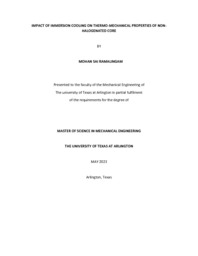
ATTENTION: The works hosted here are being migrated to a new repository that will consolidate resources, improve discoverability, and better show UTA's research impact on the global community. We will update authors as the migration progresses. Please see MavMatrix for more information.
Show simple item record
| dc.contributor.advisor | Agonafer, Dereje | |
| dc.creator | Ramalingam, Mohan Sai | |
| dc.date.accessioned | 2023-06-14T17:07:46Z | |
| dc.date.available | 2023-06-14T17:07:46Z | |
| dc.date.created | 2023-05 | |
| dc.date.issued | 2023-05-22 | |
| dc.date.submitted | May 2023 | |
| dc.identifier.uri | http://hdl.handle.net/10106/31285 | |
| dc.description.abstract | The rise in demand for modern high-power systems, which require fast processing and frequent data storage, has resulted in an exceptional and unprecedented increase in power density and heat generation within data centers. This eventually led to the need for advanced cooling techniques that can address the challenges of managing the heat produced by the data centers. As per Moore's law and Dennard's scaling, the power densities of chips and the heat flux generated by servers are continuously increasing. [1] As a result, the dissipation of heat at the chip level has also increased, posing a significant challenge for thermal management of these chips. According to a Science Magazine article, there has been a 6% rise in global energy consumption since 2010, while the computing capacity has surged by 550%.The conventional air cooled data centers consumes almost one third of the overall energy used by the facility and it has reached its limitations owing to its low cooling capacity and high power consumption Liquid cooling has many advantages over other cooling techniques because of its high heat specific capacity and high thermal conductivity of water. Due to the direct interaction of dielectric fluids with all the components in the server, single-phase liquid immersion cooling (Sp-LIC) addresses mentioned problem by offering a significantly greater thermal mass and a high percentage of heat dissipation. The conventional air-cooled data centers consume almost one third of the overall energy used by the facility and it has reached its limitations owing to its low cooling capacity and high-power consumption. Detailed study of material compatibility of the various electronics packaging materials for immersion cooling is essential to understand their failure modes and reliability. When designing electronic components, material properties such as modulus and coefficient of thermal expansion are important considerations, particularly for the substrate. The substrate is a crucial element of an electronic package and significantly impacts the failure mechanism and reliability of electronics, both at the package and board level. This study mainly focuses on two challenges. The first part of this study mainly focuses on the impact of Thermal aging on thermo mechanical properties of Non- halogenated substrate core immersed in dielectric fluids for single phase immersion cooling. The second part of this study focuses on impact of thermal aging on thermos-mechanical properties of non-halogenated substrate core in the air. The complex is calculated using the loss modulus and storage modulus of a material obtained from the Dynamic Mechanical Analyzer (DMA) for each sample. The substrate core is aged in synthetic hydrocarbon fluid (EC100), Polyalphaolefin 6 (PAO 6) and ambient air for 720 hours ~ 30 days each at two different temperatures: 85 °C and 125°C and complex modulus is characterized before and after aging and the results are compared. | |
| dc.format.mimetype | application/pdf | |
| dc.language.iso | en_US | |
| dc.subject | Immersion cooling | |
| dc.subject | EC100 | |
| dc.subject | Polyalphaolefin 6 | |
| dc.subject | Thermo-mechanical properties | |
| dc.title | IMPACT OF IMMERSION COOLING ON THERMO-MECHANICAL PROPERTIES OF NON-HALOGENATED CORE | |
| dc.type | Thesis | |
| dc.date.updated | 2023-06-14T17:07:47Z | |
| thesis.degree.department | Mechanical and Aerospace Engineering | |
| thesis.degree.grantor | The University of Texas at Arlington | |
| thesis.degree.level | Masters | |
| thesis.degree.name | Master of Science in Mechanical Engineering | |
| dc.type.material | text | |
| dc.creator.orcid | 0009-0007-4281-0756 | |
Files in this item
- Name:
- RAMALINGAM-THESIS-2023.pdf
- Size:
- 1.541Mb
- Format:
- PDF
This item appears in the following Collection(s)
Show simple item record


